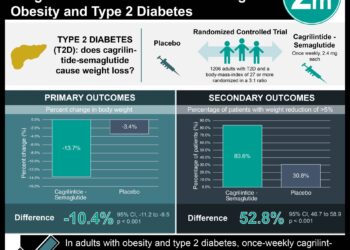2 Minute Medicine Rewind April 9, 2018
Change in Overweight from Childhood to Early Adulthood and Risk of Type 2 Diabetes
High body mass index (BMI) in children is associated with an increased risk of type 2 diabetes in adulthood. This study aimed to investigate whether achieving remission from overweight prior to adulthood mitigates this increased risk. This cohort study enrolled 62,565 Danish males and measured weight and height at 7 years, 13 years, and between 17 and 26 years. Follow-up data on 6710 research participants on type 2 diabetes status at age 30 years or older was obtained from the national health registry. Researchers found that childhood overweight, as defined by the Center for Disease Control and Prevention (CDC), was associated with an increased risk of type 2 diabetes in adulthood at all three measured ages. Specifically, individuals overweight at 13 years (HR 1.70, 95% CI 1.35 to 2.12), 7-13 years (HR 1.51, 95% CI 1.13 to 2.03) and in early adulthood (HR 3.24, 95% CI 2.93 to 3.58) were significantly more likely to develop type 2 diabetes in adulthood. However, it was found that men who had remission of overweight prior to age 13 years were not at an increased risk of developing type 2 diabetes when compared to those who had never been overweight (HR 0.96, 95% CI 0.75 to 1.21). If remission was achieved after 13 years but prior to young adulthood, however, there was an increased risk of type 2 diabetes compared to those who had never been overweight (HR 1.47, 95% CI 1.10 to 1.98). Finally, those who remained persistently overweight had the highest risk of developing type 2 diabetes (HR 4.14, 95% CI 3.57 to 4.79). Investigators therefore concluded that being overweight as a child is associated with an increased risk of developing type 2 diabetes in adulthood if not addressed prior to puberty or later ages.
All generic drug products have identical active ingredients to their branded counterparts. However, differences in appearance and excipients between the two types of drugs may contribute to desire for the branded drug, resulting in increased costs to healthcare systems. This study aimed to investigate differences in switchback rates after being switched from branded to the authorized generic drug, where the active ingredients, excipients, and appearance were the same, as compared to switchback rates after being switched to a generic drug, where the active ingredients were the same, but appearance and excipients may differ. As part of this retrospective cohort study (2004-2013), 94,909 beneficiaries of a large US commercial health insurer who had been switched from branded to authorized generic drugs and 116,017 beneficiaries who had been switched to generic products were followed up for switchback. Researchers found that the overall rate of switchback was 8.2 per 100 person-years and that rates of switchback were significantly lower in those who had been switched to authorized generic drugs, as compared those switched to generic products (HR 0.72, 95% CI 0.64 to 0.81). Investigators therefore concluded that the switch to authorized generic drug products was associated with a lower rate of switchback to branded drugs, compared to switching from branded to generic drug products.
Nivolumab plus Ipilimumab versus Sunitinib in Advanced Renal-Cell Carcinoma
Nivolumab, an antibody against programmed death 1 (PD1) immune checkpoint inhibitor, and ipilimumab, an antibody against cytotoxic T-lymphocyte-associated antigen 4, have been shown to be effective when used together in a pilot study for the treatment of advanced renal cell carcinoma (RCC). This phase 3 randomized controlled trial aimed to investigate this treatment regimen’s efficacy as compared to sunitinib, the current standard of care, in RCC patients with intermediate or poor prognostic risk. Patients (n=1096) were randomly assigned to receive nivolumab and ipilimumab intravenously every 3 weeks for a total of four doses and then receive nivolumab every 2 weeks after that, or receive oral sunitinib once daily for 4 weeks. Researchers found that the 18-month overall survival rate was significantly greater in the group treated with nivolumab plus ipilimumab at 75% (95% CI 70% to 78%), as compared to the group treated with sunitinib for which overall survival was 60% (95% CI 55% to 65%). Additionally, the objective response rate was significantly higher with nivolumab plus ipilimumab (42% vs. 27%, p<0.001). Median progression-free survival was not significantly different based on the pre-specified threshold of p=0.009, as it was 11.6 months for the group treated with nivolumab plus ipilimumab and 8.4 months for the group treated with sunitinib (p=0.03). Investigators therefore concluded that this new treatment regimen significantly increases overall survival and objective response rate, as compared to sunitinib, in patients with advanced RCC and poor or intermediate prognostic risk.
Evaluating Vaccination Strategies for Zika Virus in the Americas
Zika virus, a mosquito-borne and sexually transmitted virus, has been associated with Guillain-Barré syndrome in adults, congenital birth defects, and fetal death. In addition to vector-control measures, risk reduction related to future outbreaks will also likely require vaccination. It is expected that a viable vaccine will be available in the next several years. This study aimed to investigate the effects of a prioritization of Zika vaccination of females between 9 and 49 years, followed by males of the same age range, on the incidence of prenatal Zika infections. A model was developed that incorporated data for 34 countries and territories, and included data on country-specific mosquito density, age-specific fertility rates, sexual transmission rates, and demographic data. Assuming a vaccine efficacy of 75% and coverage of 90% of females between 9 and 49 years, researchers found that the prenatal infection rate would decrease by 94% (95% CI 92% to 95%). Expanding the coverage to include males between 9 and 49 years was projected to result in a 99% reduction of prenatal infections (95% CI 98% to 99%). Additionally, investigators found that vaccination could be more efficiently targeted to those age 15 to 29 years if an outbreak were not expected in that country for at least 10 years. Investigators therefore concluded that a vaccine for the Zika virus could have a profound effect on the reduction of prenatal infections, directly protecting those who receive it and preventing transmission.
Statins have proven effective in primary and secondary cardiovascular disease prevention. However, their efficacy in patients with acute coronary syndrome (ACS) undergoing percutaneous coronary intervention (PCI) is currently unknown. This double blind, placebo-controlled randomized clinical trial aimed to determine whether loading doses of atorvastatin, two 80-milligram doses before intervention and 24 hours after intervention, decreases the risk of major adverse cardiovascular events (MACE) within 30 days in patients with ACS scheduled to undergo invasive management. MACE was defined as a composite of myocardial infarction, unplanned coronary revascularization, stroke, and all-cause mortality. Researchers found that there was no significant difference in MACE at 30 days between with the intervention and placebo groups (HR 0.88, 95% CI 0.69 to 1.1, p=0.27). Hepatic failure was not reported in either treatment arm. Investigators therefore concluded that periprocedural loading doses of atorvastatin does not decrease the risk of MACE at 30 days in patients with ACS undergoing planned PCI.
Image: PD
©2018 2 Minute Medicine, Inc. All rights reserved. No works may be reproduced without expressed written consent from 2 Minute Medicine, Inc. Inquire about licensing here. No article should be construed as medical advice and is not intended as such by the authors or by 2 Minute Medicine, Inc.









